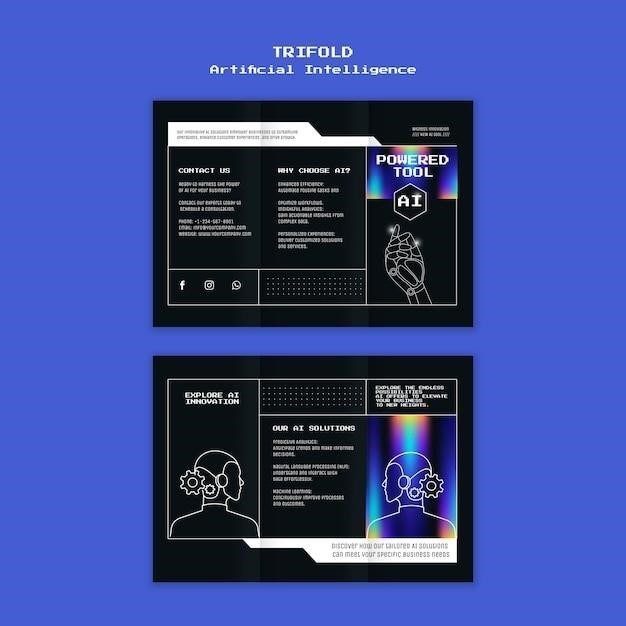tooliom tl-200m manual pdf
Tooliom TL-200M Manual PDF⁚ A Comprehensive Guide
This comprehensive guide provides a thorough understanding of the Tooliom TL-200M, a multi-functional welder capable of MIG, TIG, and stick welding. The manual covers key features, welding techniques, safety precautions, troubleshooting, and more. It’s your essential resource for mastering this versatile welding machine.
Introduction to the Tooliom TL-200M
The Tooliom TL-200M is a versatile and powerful multi-functional welder designed for both professional and DIY welding applications. This user-friendly machine is capable of performing MIG, TIG, and stick welding, making it an ideal choice for a wide range of projects. Whether you’re tackling home repairs, automotive work, or more demanding fabrication tasks, the TL-200M offers the flexibility and performance you need. Its compact size and portability allow for easy transport and storage, while its robust construction ensures durability and longevity. The TL-200M’s intuitive controls and clear LCD display make it easy to adjust settings and monitor welding parameters. This comprehensive manual provides a detailed overview of its features, capabilities, and operating procedures, empowering you to confidently utilize the full potential of this exceptional welding machine.
Key Features and Capabilities
The Tooliom TL-200M boasts a range of features that enhance welding performance and user experience. Its advanced inverter technology delivers stable arc performance and precise control over welding parameters. The TL-200M offers a maximum output current of 200 amps, allowing you to weld mild steel up to 5/32 inch thick. An intelligent LCD panel provides clear displays of welding data, enabling you to easily monitor and adjust settings. The TL-200M also incorporates safety features such as overheating protection, ensuring user safety and equipment longevity. Its multi-functional design allows you to switch seamlessly between MIG, TIG, and stick welding modes, catering to various welding needs. Whether you’re a seasoned welder or a beginner, the TL-200M’s user-friendly interface and comprehensive features make it an ideal choice for achieving professional-quality welds.
MIG Welding with the TL-200M
MIG welding, also known as Gas Metal Arc Welding (GMAW), is a versatile and widely used process for joining metal. The TL-200M excels in MIG welding, offering precise control and efficiency. Its constant voltage power supply ensures a stable arc, while the continuous wire feed and shielding gas protect the weld pool from contamination. The TL-200M allows you to adjust wire feed speed, voltage, and gas flow rate to achieve optimal welding parameters for different materials and thicknesses. The manual provides detailed instructions on setting up the MIG welding system, selecting the appropriate wire and gas, and mastering essential techniques. With its user-friendly interface and powerful performance, the TL-200M empowers you to produce high-quality MIG welds for various applications.
Understanding MIG Welding
MIG welding is a popular and efficient method for joining metals, particularly in industrial and DIY applications. It involves using a continuous wire feed, a shielding gas, and an electric arc to melt and fuse the base metal with a filler wire. The shielding gas, typically a mixture of argon and carbon dioxide, protects the weld pool from atmospheric contamination, ensuring a high-quality weld. The process is relatively easy to learn and offers versatility in welding various materials, including steel, aluminum, and stainless steel. The TL-200M’s MIG welding capabilities provide a user-friendly and powerful solution for diverse welding projects.
Setting Up for MIG Welding
Setting up the TL-200M for MIG welding is a straightforward process. First, ensure that the machine is properly connected to a power source. Then, select the appropriate wire feed speed and amperage settings based on the thickness of the material being welded. Choose the correct shielding gas, typically a mixture of argon and carbon dioxide, and connect the gas hose to the welding gun. Next, install the welding wire into the wire feeder and make sure it is properly clamped. Finally, test the gas flow and adjust the wire feed speed to achieve a consistent arc. Remember to wear appropriate safety gear, including a welding helmet, gloves, and protective clothing, before starting the welding process.

MIG Welding Techniques
Mastering MIG welding techniques with the TL-200M requires practice and understanding. Start by establishing a consistent arc by maintaining a steady distance between the welding gun and the workpiece. The arc should be smooth and stable, creating a consistent molten pool. Use a steady hand and consistent travel speed to maintain a smooth weld bead. For thin materials, use a shorter arc length and lower amperage to prevent burn-through. Thicker materials, on the other hand, require a longer arc and higher amperage for proper penetration. Practice different joint configurations, such as butt joints, lap joints, and fillet welds, to develop proficiency in various welding applications. Remember to monitor the weld pool closely and adjust the wire feed speed and amperage as needed to maintain consistent welding quality.
TIG Welding with the TL-200M
The Tooliom TL-200M is equipped to handle TIG welding, a precision technique known for producing high-quality welds. This process utilizes a non-consumable tungsten electrode to generate an arc, melting the base metal. An inert gas, typically argon, shields the weld pool from atmospheric contamination. TIG welding requires a high level of skill and control, as it involves precise electrode manipulation and careful gas flow regulation. This method is ideal for welding thin materials, stainless steel, and aluminum, where a clean, smooth weld is crucial. The TL-200M’s TIG welding capabilities allow for versatile applications, from intricate repairs to high-quality fabrication projects.

Understanding TIG Welding
TIG welding, also known as Gas Tungsten Arc Welding (GTAW), is a highly precise and versatile welding process that employs a non-consumable tungsten electrode to generate an arc. The electrode is housed within a welding torch, which also delivers an inert gas, typically argon, to shield the weld pool from atmospheric contamination. The inert gas prevents oxidation and other reactions that could compromise weld quality. TIG welding is renowned for its ability to produce clean, smooth welds, making it ideal for delicate tasks and joining various materials, including thin metals, stainless steel, and aluminum. The process requires careful electrode control and meticulous gas flow management, making it a technique that demands a higher level of skill and precision.
Setting Up for TIG Welding
Setting up for TIG welding with the Tooliom TL-200M involves careful preparation to ensure a smooth and successful welding experience. Begin by connecting the TIG torch to the welding machine, ensuring a secure connection for stable current flow. Next, select the appropriate tungsten electrode for your application based on material thickness and desired welding parameters. Attach the electrode to the torch, ensuring it is properly seated and secured. Connect the gas hose to the torch and the gas supply, ensuring a leak-free connection. Then, configure the welding machine for TIG mode and adjust the amperage based on the material being welded. Finally, select the desired gas flow rate, ensuring a steady and consistent flow of shielding gas during welding.
TIG Welding Techniques
TIG welding with the Tooliom TL-200M demands precision and control. Begin by striking an arc between the tungsten electrode and the workpiece, ensuring a stable and consistent arc. Maintain a consistent arc length, typically 1/16 to 1/8 inch, for optimal penetration and weld quality. Use a steady hand to move the torch along the weld joint, maintaining a consistent speed and angle. Control the filler metal flow to ensure proper fusion and prevent excessive weld bead buildup. For thin materials, use a weaving technique to distribute heat evenly and prevent burn-through. With practice and familiarity, you can achieve high-quality TIG welds with the Tooliom TL-200M, perfect for intricate and demanding applications.
Stick Welding with the TL-200M
Stick welding, also known as shielded metal arc welding (SMAW), is a versatile and straightforward welding process. The Tooliom TL-200M provides the necessary power and control for effective stick welding. Begin by selecting the appropriate electrode based on the material you’re welding and the desired weld quality. Strike an arc between the electrode and the workpiece, ensuring proper arc length and electrode angle. Maintain a consistent arc length, typically 1/8 to 1/4 inch, for optimal penetration and weld quality. Move the electrode steadily along the weld joint, maintaining a consistent speed and angle to ensure proper fusion and prevent excessive weld bead buildup. Use a weaving technique for thicker materials to distribute heat evenly and prevent burn-through. Remember to maintain proper electrode angle and arc length throughout the welding process for consistent and high-quality welds.
Understanding Stick Welding
Stick welding, also known as shielded metal arc welding (SMAW), is a simple and versatile welding process that uses a consumable electrode coated with a flux. The electrode is held in a welding holder and an electric arc is created between the electrode and the workpiece. The flux melts and creates a protective gas shield that protects the weld pool from atmospheric contamination. The electrode also melts and transfers metal to the weld pool, forming a weld joint. Stick welding is known for its versatility, as it can be used to weld a variety of materials, including steel, aluminum, and stainless steel. It is also a relatively inexpensive process, making it a popular choice for hobbyists and professional welders alike. Stick welding requires some skill and practice to master, but it is a rewarding process that can be used to create a wide variety of projects.
Setting Up for Stick Welding
Setting up for stick welding with the Tooliom TL-200M involves a few key steps. First, select the appropriate electrode based on the material you are welding. Ensure the electrode is clean and dry before use. Connect the electrode holder to the welding machine’s output terminal and ground clamp to the workpiece. Adjust the welding current using the machine’s controls based on the electrode type and thickness of the material. The manual provides specific recommendations for current settings. Prepare the welding area by cleaning the surfaces and ensuring a stable working environment. Wear appropriate safety gear, including a welding helmet, gloves, and protective clothing; The Tooliom TL-200M provides a user-friendly interface for easy adjustment and control during the welding process.
Stick Welding Techniques
Mastering stick welding with the Tooliom TL-200M requires practice and a solid understanding of the techniques. Start by striking an arc by touching the electrode to the workpiece and then quickly pulling it back a short distance. Maintain a consistent arc length and angle to ensure a smooth, stable weld. Use a steady hand and avoid excessive movement to prevent weld defects. Move the electrode along the joint at a consistent speed, ensuring a consistent bead width and penetration. The manual provides detailed guidelines for different welding positions, including flat, horizontal, vertical, and overhead. Pay close attention to the arc length and electrode angle for each position to achieve optimal results. Regularly check the electrode for wear and replace it when necessary to maintain consistent welding performance. Practice these techniques diligently to improve your stick welding proficiency with the Tooliom TL-200M.
Safety Precautions and Maintenance
Safety is paramount when operating the Tooliom TL-200M. Always wear appropriate personal protective equipment, including a welding helmet with proper shade lenses, leather gloves, and fire-resistant clothing. Ensure a well-ventilated workspace, as welding fumes can be hazardous. Never weld in confined spaces without adequate ventilation. Inspect the welding cables, torch, and electrodes regularly for any signs of damage or wear. Replace damaged components immediately to prevent potential accidents. After each use, clean the welding machine thoroughly, removing any debris or splatter. Store the TL-200M in a dry, clean environment, away from moisture and corrosive substances. Regular maintenance, including cleaning and inspecting the machine, will extend its lifespan and ensure optimal performance. Always refer to the user manual for specific safety and maintenance procedures.
Troubleshooting Common Issues
While the Tooliom TL-200M is a reliable welding machine, occasional issues may arise. Common problems include inconsistent arc, lack of welding power, or overheating. If the arc is unstable or intermittent, check the welding wire feed speed, electrode condition, and gas flow. If the machine lacks power, ensure proper electrical connections and check the circuit breaker. Overheating can be caused by excessive welding time or improper ventilation. Always allow the machine to cool down according to the manufacturer’s recommendations. Refer to the user manual for specific troubleshooting procedures and solutions for other common issues. If the problem persists, contact Tooliom customer support for assistance.
The Tooliom TL-200M manual serves as your comprehensive guide to utilizing this versatile welding machine. It equips you with the knowledge to perform MIG, TIG, and stick welding with confidence and precision. By understanding the key features, safety guidelines, and troubleshooting techniques outlined in the manual, you can unlock the full potential of your TL-200M. Remember to prioritize safety, follow the instructions carefully, and practice regularly to hone your welding skills. With this manual as your companion, you’ll be well-equipped to tackle a wide range of welding projects with ease and success.


